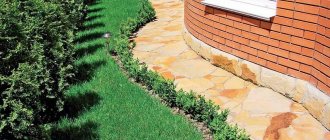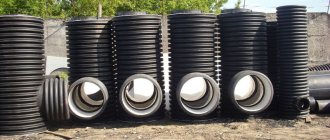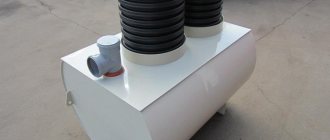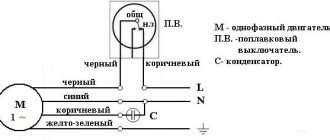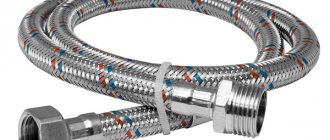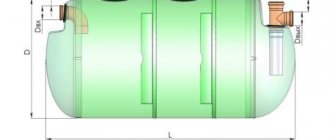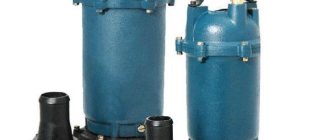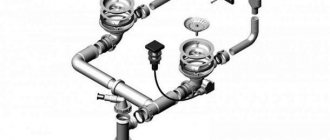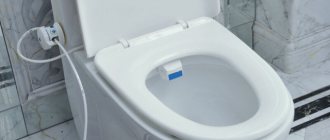Companies producing plastic drainage wells and approximate prices
There are quite a lot of companies providing plastic tanks for the drainage system to the Russian market. And this figure is constantly growing. However, the market is dominated by 2 companies that are most popular among consumers.
"Polyplastic"
This is one of the leaders among Russian manufacturers of plastic products. The company produces a full range of wells used in drainage systems. The range includes welded containers. Their tray versions can be used for installation at turns, pipeline intersections and for system inspection. Trayless products can be used as storage tanks.
The company produces differential tanks, rainwater wells, as well as prefabricated ones of various diameters. The cost of a welded well shaft is about 1,700 rubles per meter for a tank with a diameter of 40 cm, a tray of this size costs from 2,300 rubles, and a telescopic neck from 6,000 rubles.
Review: I purchased Poliplatik products to inspect the drainage system. There are no problems during assembly, nor during operation. Satisfied
The only negative is that during the selection process I could not find the price, which is important for product monitoring.
Wavin
This European company, a leader in the production of plastic products for sewerage, including for drainage systems, produces prefabricated manholes with a diameter of 315, 425, as well as larger models Wavin Tegra 600 and 1000. All of them consist of a corrugated shaft, a telescopic neck , hatch and tray with pipes.
The price for a shaft with a diameter of 425 mm ranges from 7,000 to 21,000 rubles, depending on the length. A tray of this type can cost at least 5,000 rubles.
Review: The Vavin well has been in service for more than 5 years. We are very pleased with the quality; the tank withstood temperature changes without problems. True, the prices are steep.
Purpose and design of a well for drainage
The drainage system is designed to lower the groundwater level and drain wastewater from an area with a vegetable garden, residential buildings and other structures. The drained water flows into a storage tank, from where it can be taken for watering plants or technical tasks. In other cases, the water is simply drained into a ravine or reservoir located outside the site.
The drainage system is designed to remove excess moisture from the soil into a drainage well or simply outside the site
A drainage well is a multifunctional structure made in the form of a reservoir of a certain volume. The well is an integral part of the drainage system. Depending on the type, it is used both for collecting and draining accumulated water, and for inspecting and cleaning drains. Without the installation of drainage wells, any soil drainage system will not be able to function effectively - the drains will quickly become clogged, which will lead to the need to dismantle the pipeline.
The drainage well consists of three parts:
- bottom - made both in the form of a continuous structure and in the form of a tee with a sludge collector;
- shaft - corrugated or smooth-walled pipe with a length of 2 to 6 m;
- hatch - a monolithic cover or rain inlet made of PVC, HDPE or cast iron.
Some types of drainage wells may not have a bottom - this is due to their functional purpose. Some tanks are not equipped with a water intake hatch, but are closed tightly with a special lid made of PVC or cast iron. This prevents large debris from entering the container, thereby reducing the risk of drain clogging.
Design and installation features
You can install a plastic drainage well on your site without specialists. For installation, you will need 1-2 assistants, mainly to lower the container to the bottom. But before this it is necessary to carry out preparatory work.
With a monolithic product everything is simpler; it is almost ready for installation. Disassembled finished products must be assembled according to the instructions. And if you decide to make a tank from a large-diameter pipe, then first you need to cut it to the required length.
In finished products, holes for pipes often already exist, but in home-made products, they are pre-cut in accordance with the diameter of the drains. Rubber seals and plastic couplings are inserted into the holes. All seals are lubricated with sealant to prevent leaks.
After this, they begin to dig and prepare the pit, taking into account several parameters:
- The depth should be such that the points where the pipes enter are below the freezing point of the soil, and the bottom of the container is at least half a meter above the groundwater level.
- You also need to take into account that at the bottom of the pit there will be a cushion of crushed stone 15-20 cm high.
- The width of the pit is 40-60 cm greater than the diameter of the container.
- The hatch will then have to rise 10-15 cm above the ground.
After the pit is dug, its bottom is leveled, and then a cushion of crushed stone is filled in and leveled.
If the area is characterized by a seasonal rise in groundwater, then an additional cement base must be poured onto the bottom.
After the cement has hardened, you can install:
- The reservoir is released to the bottom.
- Use a level to check whether the container is level.
- Connect the pipes for the drainage well to the nozzles. Be sure to treat all connections with sealant.
- The tank is backfilled with a sand-gravel mixture. This is done in layers, each layer being thoroughly compacted.
- Install the plastic cover (hatch).
This completes the installation. If necessary, a drain pump is released into the collector.
Installation video of the Wavin Tegra 1000 well:
Recommendations for constructing a drainage well with your own hands
It should be remembered that storm drainage is a system of pipes and other elements aimed at removing excess liquid from the site. Its main components:
- gutters and trays used to drain liquid;
- pipes through which water is transported to the right place;
- storm water inlets equipped with gratings;
- inspection well structures for monitoring the system;
- storage structures that collect wastewater from the entire system;
- filter elements (sand catchers).
The safety and integrity of the foundation and blind area of a country house is ensured by the installation of plastic rainwater inlets
Most systems are equipped with additional components that provide ease of use. Such components include alarm systems that notify of a well overflow or the presence of blockages in a storm drain.
Installation of these parts is carried out in storage and inspection type wells. Such warning systems greatly simplify sewer maintenance.
Storm sewer calculation: SNiPs and preparation
Before you start building a drainage well with your own hands, you should perform a number of preparatory steps:
- determine the type of construction;
- perform calculation;
- purchase the right materials;
- prepare the site for construction.
Modern system for collecting and draining surface water runoff
The development of the project is carried out in accordance with the conditions dictated by your site, namely:
- the nature of the placement of underground communication systems;
- annual as well as seasonal precipitation;
- the intensity with which precipitation falls in your region;
- drainage area;
- the type of coating present in the area to be drained;
- volumes of wastewater, including storm water and liquid coming from the roof.
Based on all of the above conditions, as well as the throughput of roof drains, the diameter of the pipes for the system is calculated. When developing a pipeline laying plan, be sure to take into account the specificity of the terrain located in the sewerage construction area.
Most often, for construction in private areas, pipes with a diameter of 10-15 cm are used. Moreover, in accordance with the requirements of SNiPs, the slope of the drainage pipe per 1 meter must be at least 8 mm.
Installation of a storm drainage system
The same regulatory documents also regulate the depth of pipe installation. If you purchased elements with a diameter of no more than 20 cm, they need to be laid in the soil to a depth of 30 cm or more. The laying of the sewer system in the northern regions should be carried out below the soil freezing level.
Installation of a drainage well: how to install a storm drain
Many people try to install a drainage well on their site with their own hands; this step-by-step diagram describes how to do this procedure correctly:
- an external drainage system is being installed, namely roof drains, as well as linear sewer gutters;
- guided by previously drawn up calculations and a plan, it is necessary to form trenches in the soil for laying the pipeline at the appropriate depth;
- a sand cushion is placed at the bottom of the trenches to maintain the required slope;
- installation of trays or pipes is carried out, after which all these elements are interconnected into a single system;
- Stormwater inlets are installed under drains located on the outside. These elements must be properly sealed, not forgetting to install garbage collectors and grilles;
Installation of rainwater inlets under gutters
- To install a drainage well, you need to dig a pit. Inspection-type structures are installed in places where the pipeline branches, as well as long sections of single pipes. Areas where several branches combine are suitable for placing collector wells. If you correctly distribute the elements of the system, it will be effective and last longer.
All elements of the system must be connected to each other, checked for integrity, and tested. After this, the trenches are filled with earth and compacted.
Types of drainage wells according to their functions
When arranging a drainage system, several types of tanks can be used, which differ from each other in their function and have design features.
- Inspection wells have a hard bottom; they are necessary for inspecting and cleaning the drainage system. They are installed every 20-30 meters on a straight pipeline and at pipe turns. Therefore, they often also serve as rotary ones, which is facilitated by the presence of several inlet pipes located at different angles. At least 2 pipelines enter such a container. Unused holes are hermetically sealed with special plugs.
- Storage tanks are designed to collect water and are installed at the end of the drainage system. These are completely sealed tanks, into which drainage pumps are sometimes released to empty the tank. The water accumulated in the tank can be used for technical needs. It is recommended to equip drainage tanks with sludge receptacles, so the pipes enter the tank at a height of at least 15 cm from the bottom. The inlet pipe is equipped with a valve that prevents the reverse flow of water into the system.
- Storage tanks are in some cases connected to an absorption well that has no bottom. This is a variant of soil filtration. A filter is installed at the bottom of the tank.
- In regions where excessive saturation of the soil with groundwater or atmospheric water occurs, at least seasonally, in some places pipes overflow and pressure increases in drainage. To combat this phenomenon, expansion wells are installed in particularly difficult places, which dampen the fluid pressure in the system. The principle of operation is that water from a narrow pipeline under natural pressure enters a large tank. Due to this, as well as the presence of special energy-absorbing structures inside the tank, the flow rate and pressure in the network drops.
- In places where pipelines run at different depths, drop wells are installed. Such containers are necessary where there is a large difference in relief height. The pipes in them are located at different levels. In some cases, such containers are used as a collector, which is connected to a pipeline that evacuates water collected from the site into a reservoir, ravine, etc.
- Storm wells are used in stormwater systems, which differ from drainage primarily in the depth of the gutters. A drainage well is also used in storm drainage.
Ready-made drainage wells differ not only in the functions they perform, but also in their design features.
Concrete and plastic drainage well for storm sewerage: classification
After spring melting of snow or heavy rainfall, water may accumulate on the site. If liquid lingers near a house for a long time, the moisture can erode the soil underneath and destroy the foundation. Exposure to high humidity leads to the formation of cracks in the foundation of the building and on its walls, which can ultimately lead to collapse.
Visualization of the drainage system in the local area
Features of storm drainage around the house: general provisions
If you correctly design and implement storm drainage in a private house, this system will ensure the collection of rain and melt water from the surface of the ground and roofs of houses, and also organize the effective removal of excess moisture from the site.
The place for draining liquid from the stormwater system can be:
- soil (septic tank type design);
- the nearest body of water (river, lake);
- ravine;
- home sewer system.
There are two technologies for installing storm drainage in a private house. One type of system belongs to the linear type of structure, the other to the point type.
Storm drainage can effectively prevent the negative impact of excess precipitation
The design, operating on a linear principle, ensures the collection and transportation of excess moisture not only from roofs, but also from other surfaces on the site:
- parking areas;
- blind areas;
- paved paths, etc.
Unlike point-type sewerage, in this case, not rainwater funnels, but gutters are used to collect water. These system elements are mounted flush with the sidewalk in accordance with the general slope. The structure is equipped with filters and covered with special grilles.
The operation of point sewerage is based on several rainwater receivers. They collect liquid flowing down gutters from the roof of the building. The secret of installation is to correctly connect all the elements of the system into one large highway. Through it, water will move to drainage wells for storm sewers.
Storm drainage is an integral attribute of landscaping of a residential area
Then the liquid is pre-cleaned and discharged to a place specially designated for this purpose.
Types of storm sewer wells for a private house
First of all, the classification of storm wells into groups is carried out on the basis of the material from which they are made. The material of manufacture directly affects the properties of the well and determines its characteristics, both technical and operational. The most common and most used systems are plastic and concrete products.
The classification of drainage wells for drainage of groundwater by type of construction is as follows:
- absorption;
- examination rooms;
- receptions.
Plastic varieties of systems have an expanded range of designs, due to the practicality and versatility of the material from which they are made.
The main function of drainage wells is to control operation and timely clean drainage pipes from clogging
In addition, the design of storm sewer treatment facilities can be:
- monolithic (concrete);
- collapsible (plastic).
In each case you are dealing with certain advantages and disadvantages.
Self-installation of drainage wells
Let's look at how to make a drainage well with your own hands. Depending on the type of well, the methods of its manufacture also differ.
Installation of a plastic storage well
The material for making such a well can be corrugated plastic pipe of various sizes.
Important: Wells of this type must be installed below all drainage pipelines, ensuring unimpeded flow of water to them. 1
A pit is being dug for a future reservoir.
1. A pit is dug for the future tank.
2. The required length of the corrugated pipe is measured, after which it is cut.
3. A sand cushion is poured into the hole or a solid concrete base is created.
4. A prepared container is installed in the prepared pit, which has bends for connecting pipes. Holes for inlet pipes can be made after installing the container in a permanent place. Many ready-made wells already have special outlets, so connecting them to the drainage system is easy.
5. Using bitumen mastic, a plastic bottom is glued to the pipe.
6. Drainage pipes are inserted into the well and the cracks are sealed.
7. The gaps between the walls of the well and the pit are filled with crushed stone, sand or a mixture of sand and cement.
Tip: It is advisable to immediately place a drainage pump inside the well. through which water will be pumped out. You can also use a submersible pump, which will be lowered into the well manually, as needed, or a surface type pump.
8. The storage tank is covered with a lid on top to prevent its contamination, and at this point the installation of the drainage well can be considered completed.
The installation of an inspection-type drainage well with your own hands is carried out according to a similar scheme, except for installing a pump. There is also no need to place it at the lowest point of the site.
Installation of a well made of concrete rings
For the manufacture of concrete wells, it is better to use reinforced rings with a lock. If they are not available, then ordinary concrete products will do. The thicker they are, the longer they will last.
The work is performed using special loading equipment in the following sequence:
1. A pit of the required dimensions is prepared.
2. Sand or gravel is poured onto the bottom of the pit. If a filter container is being made, the thickness of the pad should be at least half a meter.
3. The first ring with the bottom is placed on the pillow. If rings without a bottom are used, then a concrete screed is made from below the first ring.
4. The next rings are laid on top of the previous ones. When installing concrete rings, the seams between them are sealed with concrete mortar or bitumen mastic.
5. When the last ring is installed, holes are made in it (if there are none already) for the entrance of drainage pipes.
6. Pipes are inserted into the holes of the ring, after which all joints are carefully sealed.
7. A cover is installed on top of the well. You can use plastic or metal lids, as concrete products are too heavy.
8. The voids between the walls of the pit and the concrete rings are filled with sand, gravel or crushed stone.
Setting up a drainage well is not a very difficult task. You can handle this kind of work yourself, especially when installing plastic products.
Construction of a well from concrete rings
For the well, it is necessary to purchase reinforced concrete rings, which are made from moisture-resistant concrete. The dimensions and diameter of the rings are selected based on the type and purpose of the well. But it must be taken into account that their depth must be at least two meters.
Concrete rings are available in various sizes (height from 10 cm to 1 m and diameter from 70 cm to 2 m), so choosing a product will not be difficult. For a well, rings with a height of 50-60 and a diameter of 70-150 cm are usually chosen. Their weight, depending on the size, ranges from 230-900 kg.
Concrete rings are lowered one after another into a pre-dug hole and placed on top of each other.
Of course, such a weight is not impossible to lift alone, so you will have to invite one or two assistants. The structure can be installed in two ways. If the diameter of the ring allows a person to fit inside, then you can simply place it on the ground, and then begin to excavate the soil from the inside.
The ring will press with its own weight on the ground and gradually sag as soil is dug out from under it. In this way, you can install all the rings, placing them on top of each other and fastening them together with metal brackets.
The second option is to first dig a pit, the width of which should be approximately 40 cm greater than the diameter of the rings. If the soil is soft, the bottom should be covered with a 15-20 cm layer of gravel, and then concrete rings should be lowered. With this method, if an inspection or storage well is being made, it is advisable to install a lower ring with a solid bottom.
After installing the concrete rings in place, it is necessary to carefully seal all the cracks with bitumen. You can make a viewing window in the ceiling for visual inspection of the well
If there is no bottom, then you will need to make it yourself. To do this, the lower part of the well is filled with concrete mortar with reinforcement. When installing an absorption structure, the bottom of the container is equipped with a filter system, as described above.
All joints between the rings are coated with a cement-sand mixture, and then, after drying, sealed with bitumen-polymer waterproofing.
Next, from the well, according to the developed scheme, a trench is dug for drainage pipes, but do not rush to lay them, since you will first have to do another rather labor-intensive job - making holes in the concrete to connect the pipes. This can be done using a hammer drill and pobedit or diamond bits for concrete. They have different diameters, so choosing the right size is easy, but their cost is quite high.
If you don’t have a concrete crown on your farm, and you don’t want to spend money on buying one, you can resort to another cheaper method. In the place where you intend to make the branch, attach the pipe and draw a circle of the required diameter with a pencil. Drill through holes along the contour of the drawn line with a hammer drill.
Holes are drilled with a concrete drill in increments of 1-2 cm from each other, one is made in the center of the circle
Point the crowbar at the central hole and begin to break it slowly, as the hole widens, take a large hammer or sledgehammer and complete the process. Now you can bring the pipes and, putting protective rubber seals on them, insert them into the hole made. Also coat the insertion points with bitumen. Install the ceiling.
The concrete well is filled with crushed stone on all sides to a height of approximately 50 cm, and then clay is poured to the very top and compacted well. Such a clay cushion will prevent water seepage and extend the life of the well.
What materials are wells made of?
Drainage wells can be made from different materials that differ in their properties:
1. Concrete. This is a traditional material for making drainage wells. The easiest way to install a structure is from concrete rings installed one on top of the other. The walls and bottom can also be filled with concrete, especially if the drainage well is made by yourself. To do this, it will be necessary to construct formwork. Concrete is a durable and strong material, but with prolonged contact with water it gradually begins to crumble and crack.
2. Brick. They line the walls of a well, the bottom of which is filled with concrete. Brick is less durable than concrete, but it is convenient to lay even alone. It is rarely used for the manufacture of drainage systems.
3. Plastic (polymer) wells. They are increasingly replacing other materials used in drainage systems. Plastic containers have a number of advantages:
- resistance to extreme temperatures. They can be operated in a temperature range of -60+50 degrees;
- plastic is a lightweight material, so the installation of such a structure can be carried out independently, without the involvement of construction equipment;
- Installing a plastic drainage well is quick and easy. If necessary, the material can be easily cut to the required size, which is impossible to do with concrete rings;
- inert to various aggressive substances;
- they are not afraid of corrosion and oxidation;
- have strength comparable to metal and concrete;
- perfectly tolerate mechanical and hydraulic loads;
- plastic containers do not rot and are not damaged by rodents and insects;
- plastic containers can be placed at any depth and in soil with any structure;
- The durability of a plastic tank is about 50 years.
An example of a finished plastic well for drainage
Most often, corrugated pipes of various diameters made of polyvinyl chloride are used as drainage containers. A drainage inspection well, or one having another purpose, made from such pipes, has sufficient rigidity to resist being pushed out of the ground by groundwater.
Pros and cons of using plastic drainage wells
Today, every owner of a suburban area can purchase and install a storm drain made of plastic elements. And the popularity of polymer wells is growing noticeably due to their qualities that allow:
- Carry out installation work in the shortest possible time;
- Assemble a storm drainage system yourself, without involving specialists;
- Get exceptional tightness;
- Use polymer wells in any climate zone;
- Quickly increase the height of the structure when the need arises.
The low weight of plastic elements allows anyone to demonstrate their construction abilities.
Ease of installation and subsequent durability of the products save money on subsequent drainage maintenance and repairs.
The lack of corrosion and resistance to sudden temperature fluctuations also contribute to the increasing popularity of plastic storm systems.
It is impossible not to note the design feature of this product. The wavy surface, carefully covered with soil and then compacted, stays firmly in the ground even with strong heaving of the soil.
At the same time, being in constant contact with the site, a drainage well for storm sewerage made of polymer materials does not violate the ecological state of the area. With such drainage, nature remains in the same state as before the construction work began.
But, like any other product, plastic wells also have negative sides. First of all, the cost of such products.
The high price of each element makes many owners of country houses think twice. This is especially noticeable when arranging drainage in areas with a large area.
But the noticeable benefits of purchasing this product still outweigh the existing disadvantages.
Prefabricated well in the drainage system. Video:
Advantages and disadvantages of PVC manholes
For several years now, plastic products have occupied a leading position in the field of water supply and wastewater disposal, including stormwater and drainage systems. This is determined by a whole range of positive qualities of plastic products.
- One of the main advantages is its relatively light weight. Installation and transportation do not require the use of special equipment or access to the installation site. The container is very easy to install with 2-3 people.
- Plastic is a sealed material that is not subject to corrosion. The service life of such products is about 50 years, and no maintenance is required.
- Resistance to aggressive environments and low temperatures.
- High-quality PVC does not release toxic substances into the soil, so drainage containers made from it will not harm the ecological condition of the site.
The light weight of plastic products also has a disadvantage: such a container can easily float in water-logged soil.
But this problem can be dealt with using a concrete base, which is installed at the bottom of the pit and to which the well itself is attached. Another frequently cited disadvantage is the high price. But if you remember that when installing a plastic tank, there is no need to hire special equipment, and the service life is several decades, then it becomes clear that the cost will quickly pay off.
Design and purpose
Let's study the drainage well in more detail: what is it and what functions does it perform?
This structure is a reservoir of a certain size buried in the soil. The well consists of a shaft, an upper hatch and a bottom. Absorption-type structures do not have bottoms. The well allows you to accumulate excess moisture entering it from pipelines, control the degree of contamination of drainage pipes, and monitor the degree of filling of the drainage with water.
The drainage well on the site is the most important element, without which the drainage system would very quickly lose its functionality, silt up and cease to fulfill its purpose.
Types of drainage wells
There are several options for designing drainage wells, each of which performs specific tasks. Let's look at these types in more detail:
1. Viewing (inspection) well. Its purpose is to inspect and clean clogged pipes. Such structures are not intended for collecting water. Inspection wells for drainage of small diameter (up to 46 cm) are used for flushing pipelines, while larger products with a diameter of 0.9-2 m allow people to go down inside to carry out cleaning activities. Inspection wells are installed at pipe joints, as well as on very long straight sections of drainage pipelines.
Rotary inspection wells are often used, installed at the intersection of several drainage pipes, at corner points, and also at pipeline turns.
The photo shows a rotary inspection well made of plastic
2. Collector (storage) well. It is installed when the soil on the site is clayey and unable to absorb large amounts of moisture. It is also used in cases where it is impossible to discharge excess moisture outside the site. The construction of a drainage well involves the flow of water into it from the drainage system and its subsequent consumption for all kinds of household needs. Such wells are sealed. There may be several similar structures on the site. If the well is singular, several drainage pipes are connected to it simultaneously.
https://youtube.com/watch?v=YXVIi7M1Yr8
The diameters of plastic pipes for the manufacture of such wells start from 57 cm. The deeper the tank, the slower it will fill, and it is installed at the lowest point of the site, below the passage of the drainage pipes.
Construction of a drainage well with a pump
3. Absorption (filter) well. Its use is advisable in cases where it is not possible to remove drainage water outside the site or into the central sewer system.
The absorption well for drainage is usually more than 2 meters deep. A layer of broken brick, slag or gravel about 30 cm thick is poured into the bottom of the structure, which helps absorb water into the ground. The upper part of the well is covered with geotextile, on top of which a layer of soil is poured.
Absorption wells are often installed as the last stage of wastewater treatment after a septic tank
The use of a filter well is justified on sandy and sandy loam soils with high absorption capacity.
Features of drainage structures
Drainage is required only when the building is located in a low area or the groundwater level is higher than the basement or plinth of the building and there is a high probability that they will be flooded. It is especially important to equip a drainage system in the garden area located on clay soils that have a tendency to heave if they freeze in the cold season.
At the same time it can perform a number of functions:
- helps reduce groundwater pressure on the floor and walls of the building;
- prevents the possibility of basement flooding;
- drains the area.
Experts advise laying a drainage structure at the stage of preparing a pit for the future construction of a house, so as not to disturb the landscape of the adjacent territory in the future, when the construction of outbuildings on it has already been completed. Before installing the system, a trench is dug along the perimeter of the building.
It should be located at a distance of 1.5 to 3 meters from the pit or building, if it has already been erected. Next, a closed pipeline is laid in the trench and, in certain places, a drainage well is constructed - one or several. Their number depends on the size of the site, the depth of groundwater, soil type and other factors.
The drainage structure should not be confused with a storm sewer - the differences between them are significant. In the second case, the structure is intended to remove precipitation and is usually placed on the surface of the site. Drainage pipes are laid below the base of the foundation.
Classification of underground drainage tanks by type of construction
Based on this criterion, ready-made PVC tanks are divided into 2 categories.
Prefabricated wells consist of several elements that are connected to each other before installation:
- main tray with pipes;
- shaft, which can be a corrugated or smooth pipe;
- two sealing rings for connecting the body (shaft) of the well with the neck or tray;
- neck;
- plastic cover;
- extension cord, the length of which may vary depending on the installation depth.
Such tanks are more versatile, since the length of the shaft can be adjusted depending on the depth, but they are more expensive
It is important to take into account that as the length increases, the resistance of the container body to compression decreases.
Monolithic tanks are more durable and cheaper, but have a standard height and are therefore designed for installation at a certain depth. True, the additional installation of the neck allows them to be deepened a little. Drop and expansion tanks are produced only in this form.
Monolithic and prefabricated products are produced both in Russia and abroad.
Types of drainage wells
There are several options for designing drainage wells, each of which performs specific tasks. Let's look at these types in more detail:
1. Viewing (inspection) well. Its purpose is to inspect and clean clogged pipes. Such structures are not intended for collecting water. Inspection wells for drainage of small diameter (up to 46 cm) are used for flushing pipelines, while larger products with a diameter of 0.9-2 m allow people to go down inside to carry out cleaning activities. Inspection wells are installed at pipe joints, as well as on very long straight sections of drainage pipelines.
Rotary inspection wells are often used, installed at the intersection of several drainage pipes. at corner points, as well as at pipeline turns.
2. Collector (storage) well. Installed when the soil on the site is clayey. unable to absorb large amounts of moisture. It is also used in cases where it is impossible to discharge excess moisture outside the site. The construction of a drainage well involves the flow of water into it from the drainage system and its subsequent consumption for all kinds of household needs. Such wells are sealed. There may be several similar structures on the site. If the well is singular, several drainage pipes are connected to it simultaneously.
The diameters of plastic pipes for the manufacture of such wells start from 57 cm. The deeper the tank, the slower it will fill, and it is installed at the lowest point of the site, below the passage of the drainage pipes.
3. Absorption (filter) well. Its use is advisable in cases where it is not possible to remove drainage water outside the site or into the central sewer system.
Tip: Use this type of well if the total volume of wastewater in your area is not too large (up to 1 cubic meter per day).
The absorption well for drainage is usually more than 2 meters deep. A layer of broken brick, slag or gravel about 30 cm thick is poured into the bottom of the structure, which helps absorb water into the ground. The upper part of the well is covered with geotextile, on top of which a layer of soil is poured.
Absorption wells are often installed as the last stage of wastewater treatment after a septic tank
The use of a filter well is justified on sandy and sandy loam soils. having high absorption capacity.
Tip: If the walls of the absorption well have cracks, it is recommended to lay a layer of geotextile on them, which will filter the water penetrating through them.
Installation of plastic inspection and storage tanks
If you purchased a plastic container for a drainage well, you only need to install it correctly on a pre-made base. The installation of these two types of structures is almost similar. The difference may lie in the number of outlet pipes, the parameters of the wells and their different locations, which can be vertical or horizontal.
Inspection structures, as a rule, are created in a vertical position, and storage structures can be equipped in both vertical and horizontal versions. In addition, collector wells are equipped with drainage pumping equipment, and pipes are discharged into a drainage basin.
Before you begin constructing a well intended for collecting and further discharging drainage waste, you need to dig a ditch, perform a series of preparatory steps described earlier, and lay pipes, but do not fill them up.
The installation of the well is carried out in stages:
- On a personal plot, in the area allocated for the installation of the structure, the soil is deepened to about 40 centimeters from the level of laying the pipes.
- Layers of sand and crushed stone are poured and compacted.
- Prepare a concrete solution at the rate of 3 parts sand and 1 part cement and fill the bottom with it.
- After the base has hardened, when it is completely prepared, which takes about two days, a layer of geotextile is laid.
- The container is placed on a concrete base and the pipes are connected to the outlets.
At the final stage, a hatch is installed on top and the structure is covered on all sides with crushed stone and soil.
What materials are wells made of?
Drainage wells can be made from different materials that differ in their properties:
1. Concrete. This is a traditional material for making drainage wells. The easiest way to install a structure is from concrete rings installed one on top of the other. The walls and bottom can also be filled with concrete, especially if the drainage well is made by yourself. To do this, it will be necessary to construct formwork. Concrete is a durable and strong material, but with prolonged contact with water it gradually begins to crumble and crack.
2. Brick. They line the walls of a well, the bottom of which is filled with concrete. Brick is less durable than concrete, but it is convenient to lay even alone. It is rarely used for the manufacture of drainage systems.
3. Plastic (polymer) wells. They are increasingly replacing other materials used in drainage systems. Plastic containers have a number of advantages:
- resistance to extreme temperatures. They can be operated in a temperature range of -60+50 degrees;
- plastic is a lightweight material, so the installation of such a structure can be carried out independently, without the involvement of construction equipment;
- Installing a plastic drainage well is quick and easy. If necessary, the material can be easily cut to the required size, which is impossible to do with concrete rings;
- inert to various aggressive substances;
- they are not afraid of corrosion and oxidation;
- have strength comparable to metal and concrete;
- perfectly tolerate mechanical and hydraulic loads;
- plastic containers do not rot and are not damaged by rodents and insects;
- plastic containers can be placed at any depth and in soil with any structure;
- The durability of a plastic tank is about 50 years.
Most often, corrugated pipes of various diameters made of polyvinyl chloride are used as drainage containers. A drainage inspection well, or one having another purpose, made from such pipes, has sufficient rigidity to resist being pushed out of the ground by groundwater.
If you are looking for the best dry closets for your home, prices, reviews and features of their operation are described in our separate material.
We described the characteristics of the Brooks pump here. It can do an excellent job of pumping water out of storage tanks.
Pumping water from a drainage well
It is optimal if the drainage well is directly connected to the central sewerage system, but in most cases this is impossible to do in country and suburban areas.
The easiest way to drain water is to remove the drain pipe outside the site. As the well shaft fills, there will be a natural flow of water into a ravine or reservoir. Before installing a drain, you should contact your local water utility and find out whether it is possible to install such a discharge point without approval from the authorities.
A submersible pump with a float is used to pump water from storage drainage wells
A submersible pump is used to forcibly pump water out of the well. The unit is connected to the central network, and the filling level is monitored by a special float sensor on a short cable.
The throughput of the pump depends on its power and the contamination of the wastewater. If the drainage system collects water from a storm drain, it may contain large particles of debris up to 50 mm in size. This is also taken into account when choosing a pump. To pump water collected exclusively from the ground, a pump with a permissible diameter of solid particles of 5–7 mm is sufficient.
During operation of the drainage well, the bottom should be washed away with a strong pressure of clean water. As a rule, this is done by completely pumping out the water from the tank once a month.
Video: drainage well with water drainage outside the site
With the correct installation of the drainage system, you do not have to worry about the safety of the materials used for the construction and cladding of the building, and the crops growing on the site will receive the amount of moisture necessary for their normal functioning.
- Author: Vitaly Varlamov
Hello. My name is Vitaliy. Area of professional activity: technical means of automation and design technologies. Rate this article:
- 5
- 4
- 3
- 2
- 1
(1 vote, average: 5 out of 5)
Share with your friends!
Types and design of drainage wells
Filter drainage well
All wells of the drainage system are classified according to their purpose:
- Audit. Designed to assess the state of all communications. The inspection shaft must have sufficient volume so that a person can descend there if repairs are necessary. More often, the revision is mounted on extended sections of the system (from 10 meters) or on its turns.
- Perepadny. It is installed if the drainage system is installed on a difficult terrain and the master is unable to maintain its smooth slope in specific areas of the site. Has a sealed bottom.
- Turning. A type of inspection well designed for making sharp bends in the system.
- Absorption (drainage). It is also often called filtering. As a rule, it is installed if it is not possible to discharge accumulated moisture into the city highway. The absorption well is the final point of water removal from the site and is located in its lowest part. The filter shaft does not have a sealed bottom. Instead, a drainage cushion of crushed stone and pebbles is laid.
- Storage (collector septic tank). This is a tank with a sealed bottom to collect rainwater. Subsequently, the liquid is either discharged using a pump into the nearest reservoir/ravine, or used for economic purposes (irrigation, watering).
Installation of a plastic absorption well
Creating a filter-type well for drainage with your own hands using plastic containers is done using products without a bottom. Their installation is carried out in the same way as described above, except for pouring the concrete base.
At the bottom of the well, instead, a filter system is created that can purify the incoming liquid naturally. Gravel, crushed stone or other similar bulk material with a thickness of 20 to 30 centimeters is poured into one layer at the bottom.
Pipes are laid to the top of the structure and covered with gravel or crushed stone on all sides, covered with geofabric on top and finally covered with a hatch. In order for a filter well to work productively for a long period, it must be installed correctly.
Material of manufacture
Drainage wells made of concrete and plastic
For the manufacture of drainage system wells, two popular types of materials are used:
- Plastic. The polymer is light in weight, which is convenient when installing a system at the dacha with your own hands. In addition, plastic (polyethylene, polypropylene) is resistant to aggressive environments and inert to temperature changes. And special rings in the corrugation of a polymer pipe play the role of stiffeners. That is, such a shaft resists seasonal heaving well and is prone to linear stretching. It is worth considering that it is easier to work with plastic when forming holes for drains. And the polymer lasts for 50 years or more.
- Concrete. Strong, strong and durable material. A well made of concrete rings is firmly secured even in very heaving soil. Due to the fact that the tank is assembled from separate elements, it is possible to install shafts of different heights. Concrete lasts no less than plastic. But when constructing a well, it is necessary to use special equipment, since the mass of the rings is impressive.
If you work carelessly with concrete rings, you can damage the structure of the material. Concrete can crack under strong mechanical stress
Construction materials
Wells used to create a drainage system on a personal plot with your own hands are usually assembled from concrete rings or purchased in plastic containers of certain sizes.
How to make a drainage well and what materials to use is decided by each owner of a country house himself. But it should be taken into account that the cost of the first option is cheaper, but requires more labor, and the second is much easier to manufacture, but its price is higher.
The assembly of wells from concrete rings requires solving a number of problems. Due to the significant weight of the rings, it is necessary to order special equipment and pay for the labor of assistants. In concrete wells, you need to create holes for laying pipes, and such work is difficult.
As a result, the labor intensity of installing a concrete structure is compensated by its durability, strength, reliability and affordable cost. Such a self-made drainage well has increased resistance to negative influences. It can be placed anywhere, as well as in areas located on soils subject to heaving when they freeze or in the event of hydrothermal shifts.
Under the same operating conditions, plastic products for wells can be deformed, despite the fact that they are easy to install, reliable and convenient. Their body already contains holes of the required diameter, intended for laying and connecting pipes.
Often owners prefer combined installation options. They buy plastic tanks for rotary and inspection structures, and create filtering and storage wells from concrete rings. There is another inexpensive option - this is the independent production of containers from plastic pipe products.
